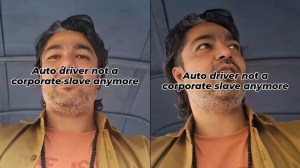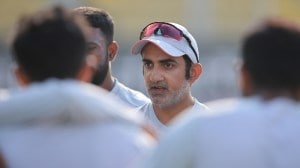As the Indian Space Research Organisation (ISRO) makes its foray into the commercial launch market around midnight Saturday with the launch of 36 satellites on board the GSLV MkIII, its heaviest rocket, a group of schoolgirls from around the country are preparing for another launch that they hope will put a satellite they worked on into orbit in December.
The first development flight of the Small Satellite Launch Vehicle (SSLV) in August was life-changing for Simran, Tanvi, and Hari, who were part of a team of 750 girls that developed the 8-kg AzaadiSAT that was launched aboard it. This and other satellites launched that day failed to achieve orbit, but that has not discouraged the girls who are set to attempt the feat again. Their satellite is likely to be launched in December.

The three girls helped in coding the temperature, humidity and spatial sensors used in the satellite.
For Simran from Amritsar, learning about space and space technologies opened up new avenues.
“I don’t want to be an engineer, I don’t like Maths. I want to become a doctor. But what can a doctor do in space?” she wondered aloud. When she realised that India would soon be sending astronauts to space, she was overjoyed. “I can be a space doctor!” she said.

Not liking Maths, however, did not stop Simran from coding. “The team from Space Kidz India (Chennai-based aerospace organisation) took online classes initially, then our Sir explained everything. All of us together were able to code the chip that was sent to us,” she said. She studies in Class 11 at Government Girls Senior Secondary Smart School, Amritsar.
She started taking an interest in space after she worked on the project earlier this year, and now she wants to know whether there could indeed be life on Mars.
Story continues below this ad
Simran, whose father is a plumber and mother a housewife, dreams big now. “I met so many big scientists when I went for the launch. Now, I know I want to do something big,” she said.
Hari Vaishnavi, who is in Class 10 at Government Girls Higher Secondary School in Thirumangalam, Tamil Nadu, was amazed that the sensor they coded — after several hits and misses — could detect the temperature and moisture from her palm when she placed her hand over it. She wants to work to develop space technology.
The sensors developed by the girls were then integrated by a team of students from Space Kidz India.
“We want to change the image of rural India. We do not want people to think of girls working in their homes or farming, we want to create an image of children who are sending satellites to space,” said Dr Srimathy Kesan, founder and CEO of Space Kidz India.
Story continues below this ad
The students mentored by her and her team went to Sriharikota to witness the August launch, and even though they learnt that the satellite could not remain in orbit the next day when they were in Chennai, she kept their morale high.
“She did not look sad at all. She said that we learn from our mistakes. Now, we will get to work on the second satellite. I know, that we cannot achieve success every time — we can control what happens on Earth, but once a satellite is in space we cannot do anything,” said Tanvi Patel, who is in Class 11 at Shree B S Patel Kanya Vidyalaya in Ladol village, Mehsana, Gujarat.
The students in Tanvi’s school worked on two sensors — one that captured temperature and humidity data, and another that kept track of the altitude and velocity of the satellite. “These micro-controllers were like the brain of the satellite — giving directions and storing data. Through the project we learnt something new, something that was never a part of our syllabus. If possible, I would like to study engineering and work in ISRO,” said Tanvi.
The girls were also supported by mentors like teacher Hilal Ahmad Sofi from Government Girls Higher Secondary School in Ganderbal, Jammu and Kashmir.
Story continues below this ad
“Although the students from my school were from Class 9 — most of the work on the satellite was done by students from Class 10 and 11 — they got to ideate with the others, they got to learn about space and space technology. They realised that space was not just for the scientists, anyone can do it. For them, it was no longer a story they were reading in the books, it was practical, their project actually went to space.”










